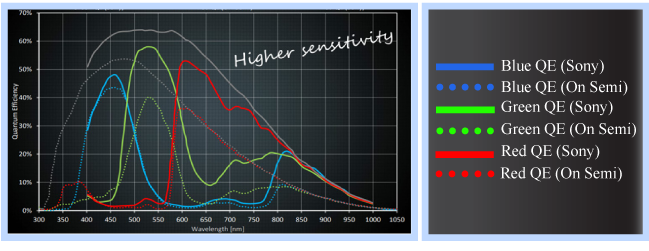|
||||||||||||||||||||||||||||||||||||||||||
|
||||||||||||||||||||||||||||||||||||||||||
Machine vision imaging industry shifts away from CCD sensors
Go to Allied Vision
Technologies
| Allied Vision
transitional plan On Semiconductor announce discontinuance of CCD Sensors |
|||||
|
German manufacturer of high quality machine vision cameras, Allied Vision Technologies, has outlined its transitional plan as the imaging industry shifts away from large format CCD. The industry shift has direct implications for Allied Vision Technology and specifically, its KAI sensor cameras. AVT's KAI sensor cameras feature high resolution, high performance CCD sensors that have been on the market for a number of decades, previously known as Kodak and Truesense. The sensor series was most recently purchased and owned by On Semiconductor, who have recently declared their intentions to cease manufacturing these sensors. On Semiconductor attributed turbulent sales activity
revealed in its own analysis as a key factor in its decision. On Semi's decision to discontinue the KAI range
of sensors reflects the growing industry trend to use the modern
CMOS sensors. CMOS has made huge advancements in recent years and
continues to evolve rapidly. |
|||||
 |
|||||
|
The Allied Vision GT series is a series of high performance machine vision cameras designed for imaging in extreme temperatures (from -20°C up to 65°C) as well as fluctuating lighting conditions. The Prosilica GT cameras feature DC Auto Iris, as well as PoE and the latest CMOS sensor technologies making them ideal for a wide range of demanding applications including ITS & traffic imaging, machine vision, industrial inspection, security, surveillance, military applications and more. Four of Allied Vision GT models with On Semi KAI sensors have recently been discontinued and are replaced with models using the Sony Pregius sensors. The specifications of the new cameras are not identical but the performance in many ways is as good if not better. |
|||||
The
AVT GT 6600 with a KAI-29050 is being replaced by the GT6400 with
a sony IMX342 sensor,
|
|||||
| Comparing
the Prosilica GT 6600 with the new
Prosilica GT 6400: |
|||||
| Model |
Prosilica GT 6600* | Prosilica GT 6400 | |||
| Sensor |
On Semi KAI 29050 (CCD) | Sony IMX342 | |||
| Resolution |
6576 x 4384 (28.8 MP) | 6480 x 4860 | |||
| Pixel Size |
5.5 µm x 5.5 µm | 3.45 µm x 3.45 µm | |||
| Sensor Format |
type 35mm | Type APS-C | |||
| Frame rate |
4 fps | 3.82 fps | |||
| Quantum
efficiency at 529 nm |
40% | 31% | 65% | |||
| Power consumption
|
6.6 W at 12 VDC; 8.1 W PoE | 5.4 W at 12VDC; 6.7 W Poe | |||
| *Discontinued | |||||
| Comparing
the Prosilica GT 4907 with the new
Prosilica GT 5400: |
|||||
| Model |
Prosilica GT 4907* | Prosilica GT 5400 | |||
| Sensor |
On Semi KAI-16070 | Sony IMX387 (CMOS) | |||
| Resolution |
4864 x 3232 (15.7 MP) | 5472 x 3084 (16.8 MP) | |||
| Pixel Size |
7.4 µm x 7.4 µm | 3.45 µm x 3.45 µm | |||
| Sensor Format |
Type 35mm | Type 4/3 | |||
| Frame rate |
7.6 fps | 7.14 fps | |||
| Quantum
efficiency at 529 nm |
46% | 34% | 65% | 58% |
|||
| Power consumption
|
7.7 W at 12 VDC; 9.5 W PoE | 5.2 W at 12VDC; 6.7 W Poe | |||
| *Discontinued | |||||
| Comparing
the Prosilica GT 4905 with the new
Prosilica GT 5400: |
|||||
| Model |
Prosilica GT 4905* | Prosilica GT 5400 | |||
| Sensor |
On Semi KAI-16070 | Sony IMX387 (CMOS) | |||
| Resolution |
4896 x 3264 (16 MP) | 5472 x 3084 (16.8 MP) | |||
| Pixel Size |
5.5 µm x 5.5 µm | 3.45 µm x 3.45 µm | |||
| Sensor Format |
Type 35mm | Type 4/3 | |||
| Frame rate |
7.6 fps | 7.14 fps | |||
| Quantum
efficiency at 529 nm |
46% | 34% | 65% | 58% |
|||
| Power consumption |
7.7 W at 12 VDC; 9.5 W PoE | 5.2 W at 12VDC; 6.7 W Poe | |||
| *Discontinued | |||||
|
|
The new Sony Pregius CMOS sensor equivalents offer several advantages over the previous KAI CCD models resulting in outstanding image performance. These include: -- higher quantum efficiency -- higher dymanic range -- greater spatial resolution ... Here to advise The replacement CMOS sensors have differences to the previous CCD sensors. For example the pixel size for the CMOS sensors is considerably smaller nwhich will affect the requirement for the optics. Adept understands that, replacing current CCD-based systems with CMOS technology may require advice and support from us. Please call us for a conversation. |
||||
| Need
a price or more information? Please
email Adept us or call our offices Adept Turnkey Pty Ltd Smarter Imaging
for Better Lives. Distributor of AVT in Australia and New Zealand |
|||||
|
If you like this page, please recommend it and share it. |
|||
| More | |||




